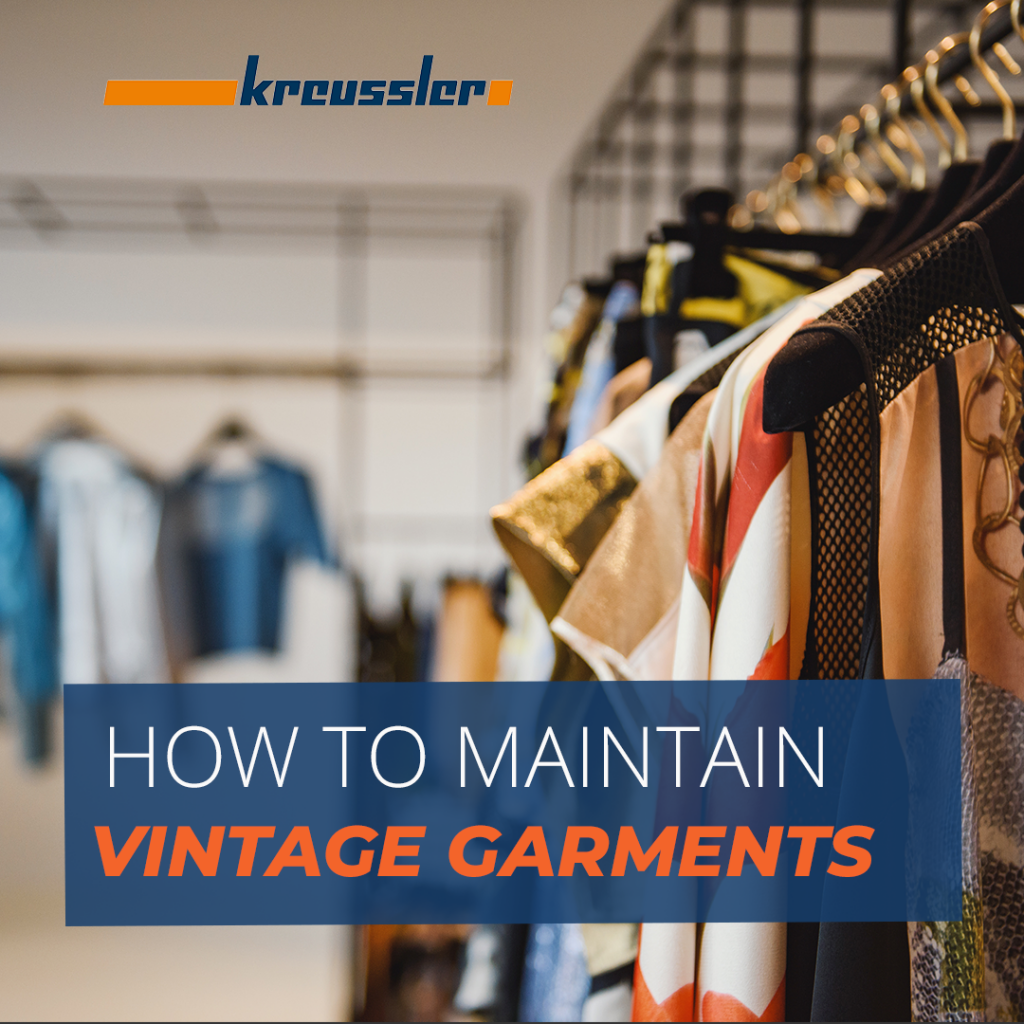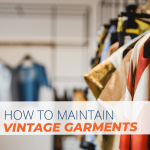
If you have made a commitment to buy fewer new things in 2020, hitting your local consignment shop or vintage store is a great place to refresh your wardrobe. Buying second-hand garments is better for the environment than purchasing fast fashion. This article will share how you can maintain vintage garments and get them ready to wear.
“The fast fashion industry (referring to fast-turnover high street retailers) generates 100 billion garments per year. It is one of the most polluting industries in the world, after oil. This is because retailers restock collections every 4-6 weeks, pressuring us to buy more and think less, leaving a considerable amount of unwanted clothing to discarded at the landfill – the majority of which can actually be recycled.” [from Fashion Revolution]
You may also be able to score some great garments from your mother or grandmother. Don’t be afraid to take something that has been in the attic or a closet for years.
One practical rule is DO NOT use your home washer or dryer, especially if the garment does not have a garment care label. The agitation and heat from modern appliances might ruin your garment on the first try. Vintage fabrics need extra TLC.
Here are a few ways that you can revive and maintain vintage garments:
- Bring to a professional to assess fabric and care, especially if your garment doesn’t have a care label
- Start with a good cleaning to take care of yellowing or other discoloration and stains
- Have a seamstress fix any tears, broken zippers, or replace buttons
- Store garments properly: no plastic bags or wire hangers
Finding a dry cleaner that uses the wet cleaning process [cleaning with professional equipment in a solvent-free, gentle process] and has experience cleaning vintage garments would be helpful. Call your local cleaners and ask them a few questions to make sure they can process your garments.
Selecting vintage from a store or family closet, you need to keep a few things in mind. A skilled professional cleaner can correct some common issues, and some may not. It is essential to know the difference.
What your professional cleaner can usually fix:
Funky smell
Garments that are stored improperly can become damp or musty, allowing mold spores to culture. They can also pick up the surrounding odor of a stale cardboard box or the basement/attic.
Dry cleaners have several tools available to them to safely and adequately deodorize and “decontaminate” musty or mildew smelling textiles. Still, it is important to note that visible mold stains are tough to remove, usually requiring a chlorine bleach that will damage most vintage fabrics.
There is also the health risk of handling items with active mold spores, so be cautious. If the item has mold, you need to make sure it is completely dry before handling it and be realistic about the stains. A dry cleaner can remove the mold and the odor, but the stain may remain. If mold is an issue, it might be better to pass on the item.
Yellow stains
Sugars from beverage stains oxidize over time and turn yellow, think of an apple left to sit after someone takes a bite out it. Many times these stains can be removed through professional wet cleaning and using a gentle color safe oxidizing bleach (remember bleach is a generic term, applied to many chemicals that can disrupt the flow of electrons in a substance, making them invisible to the human eye, don’t assume chlorine when you hear bleach).
Yellowing can occur from sun damage if the item hung in a window or near a natural light source for a long time. This can be harder to correct as the damage is now directly tied to the fabric or finish on the item. Where the yellow is on the garment can help in identifying the source, small drops, or spill like patterners down the front= old sugar stain. Yellowing on the shoulders, on only one side or in long streaks, can be sun damage. Your dry cleaner can help you with both, but sun damage is usually permanent.
Finally, take a look at the underarm area; if you see yellow stains here, you should assume they are permanent, especially if the fabric is silk.
Holes/ tears
It’s important to check the items carefully for holes and tears. If you find any evidence of insect activity, you should assume there is more that you can’t see. Cleaning the garment will “flush” away the tiny bits of fabric damaged but not consumed by the insect, and your vintage cashmere sweater with a few moth holes before cleaning now looks like macramé.
If you are confident that you have found all or most of the holes, be sure to have them mended before cleaning, preventing edges from tattering or fraying, and getting more prominent in the process.
Your dry cleaner usually has a tailor or seamstress available to help with tears, broken zippers, missing buttons (although not always an exact match), and snaps. Don’t be turned off if there is some wear on the piece but need to make sure the material is sound if it is tearing apart in your fingers, if there are larger areas of missing fabric or if the finish or applique is damaged or missing that needs to be considered.
Fading
Many dyes can and will fade over time, and some dyes that look alright will flush out on the cleaning process without a good method of testing beforehand. If you are eyeing a deeply pigmented item, especially if its silk, cotton or linen make sure you discuss this with your cleaner. They do have the ability to reduce the mechanical action time and temperature of the cleaning process to help mitigate any dye loss, but this doesn’t mean they can prevent it completely.
Dyes that have already faded aren’t going to get better by cleaning and will probably be lighter after the process. Re-dying fabric is usually out of the scope of most cleaners, but you can always ask.
No need to be daunted by reviving your garments – just have a plan to maintain vintage garments. Treat your vintage garments like the treasures that they are and enjoy having something unique and exciting in your closet.

